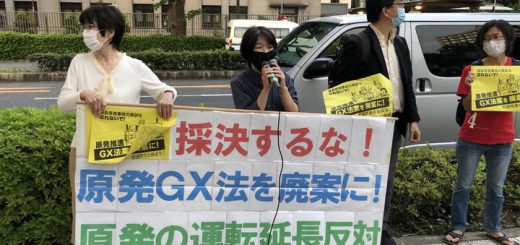Fukushima Now Part 1: Fukushima Reaches a Turning Point
By Yamaguchi Yukio (CNIC Co-Director)
After the nuclear catastrophe in Fukushima in March 2011, the town of Futaba, located in Hamadori (the Fukushima coastline), became the only municipality in Fukushima Prefecture to decide to move its administration out of the prefecture. After changing evacuation sites several times, gradually moving further and further away from Futaba, the town’s government offices and many of its residents settled in a disused school in Kazo City, Saitama Prefecture, at the end of March 2011. It seemed as if the nuclear power plant town, where Fukushima Daiichi Nuclear Power Station (FDNPS) reactors Units 5 and 6 are located, had “drifted” 250 kilometers away from home. The evacuation was ordered based on the Special Act on Nuclear Emergency Preparedness and Response, and it was a difficult evacuation, the people evacuating “with nothing but the clothes on their back.”
The evacuation order for Futaba Town was lifted on August 30 this year, eleven-and-a-half years after it was imposed. However, there are very few who are willing to return to their hometown. As of March 2022, 19 households (26 people), or 0.4% of the pre-disaster level, had applied for “Preparation of Accommodation.”* The rich natural environment that was once part of the area no longer exists, and there is no prospect for the revival of community life.
The decommissioning of the plant at FDNPS is not expected to be completed anytime soon, as nothing like this has been experienced before and the radiation is likely to cause unexpected issues. That is not a problem when fission is used as a nuclear weapon, because the objective is to annihilate the opponent. However, that is not the case for “commercial use.” International organizations promoting nuclear power have set “standards” (radiation dose limits), but they are not reliable. It is impossible to properly evaluate the effects of low-dose exposure with current scientific knowledge alone. It is also a trans-scientific issue (a question that can be asked by science but cannot be answered by science).
The government decided on a plan to treat the radioactive water from FDNPS with ALPS, reduce its radioactivity level, and then discharge it into the ocean. The plan is to be implemented from 2023. The government and those who support the plan claim that there is no safety problem because the concentration will be much lower than the standard, even though the “standard” itself is questionable. However, that cannot be proven. It is only possible to prove it by repeating experiments under exactly the same conditions (including in the natural environment) as exist in reality and obtain results with a sufficiently high degree of confidence in the effects on humans as well as on ecosystems. It may be possible to do so, but it would probably take hundreds of years. The experiments might also lead to irreversible disasters. This kind of “experiment” is not feasible because it would take a long time and be too costly. In addition, simulations are also unlikely to allow us to draw solid conclusions.
There are many who are opposed to the oceanic release plan by the government and TEPCO, and who have presented reasons for their opposition. One thing I would like to add about “harmful rumors” is that this expression has the connotation of “irresponsible rumors that make something which is actually harmless appear to be harmful.” I do not agree with this connotation.
The government and nuclear energy proponents pushed forward the nuclear power plants without regard for the opinions of citizens and residents. This caused a nuclear catastrophe, the government has adopted an evacuee return policy without taking responsibility, and it is now about to discharge contaminated water into the ocean. The reason why such an absurdity has occurred is that the government has become extremely powerful. The separation of legislative, administrative, and judicial powers is said to be the basis of democracy, but the equilibrium of these three powers has been seriously disturbed. Nevertheless, the Mito District Court decision (Tokai Daini NPP Lawsuit, 18 March 2021) , the Sapporo District Court decision (Tomari NPP Lawsuit, 31 May 2022), the Supreme Court’s opinion by Justice Miura (17 June 2022), and the Tokyo District Court judgement (TEPCO Shareholder Lawsuit, 13 July 2022) remind us that the judiciary still exists.
Sun Yat-sen (1866-1925) once advocated the idea of a “five-power constitution” on the grounds that the three powers alone were not sufficient. Considering the current situation in Japan, I suggest the right to vote alone is powerless to curb the tyranny of the government. We need more powerful civic rights so that ordinary citizens can get together and be as powerful as the other three institutions.
Although the existence of “experts” is crucial in today’s world of science and technology, there are still many problems that cannot be answered by “experts” alone. Eleven-and-a-half years after March 11, METI committees, acting as if Fukushima is now history, often use expressions such as “innovative reactors” and insist that “nuclear power is the key to decarbonization.” I believe citizen power is needed more than ever before.
*”Preparation of Accommodation”: A system that allows disaster victims to stay overnight in their homes, which is prohibited in the evacuation zone, in order to facilitate preparations for a smooth resumption of life in their hometowns after the evacuation order is lifted.

